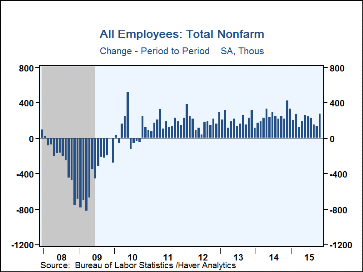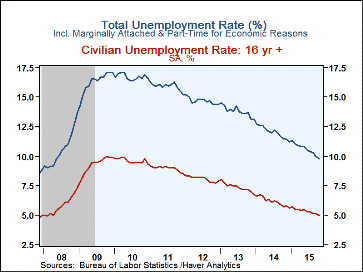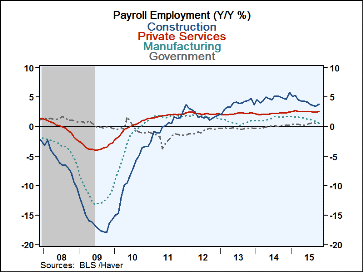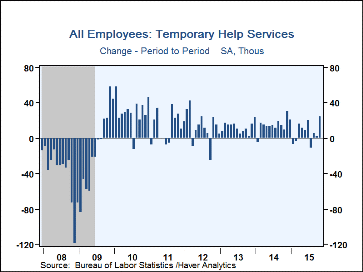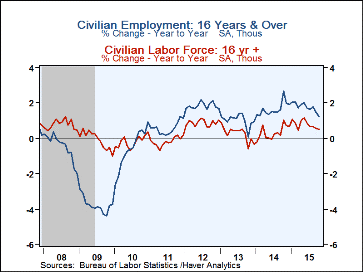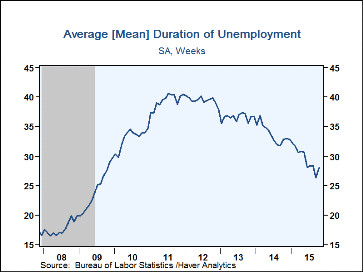 Global| Nov 06 2015
Global| Nov 06 2015U.S. Payroll Increase is Largest This Year; Earnings Strengthen and Jobless Rate Declines
by:Tom Moeller
|in:Economy in Brief
Summary
The labor market exhibited unexpected strength last month. Nonfarm payroll employment increased 271,000 during October following revised gains of 137,000 and 153,000 during the prior two months. Together, revisions added 12,000 jobs. [...]
The labor market exhibited unexpected strength last month. Nonfarm payroll employment increased 271,000 during October following revised gains of 137,000 and 153,000 during the prior two months. Together, revisions added 12,000 jobs. The latest increase was the largest since December and beat expectations for a 178,000 rise in the Action Economics Forecast Survey. Stronger employment brought with it improved earnings. Average hourly earnings gained 0.4%, raising the twelve-month increase to 2.5%, a six-year high. A 0.2% rise had been expected. The unemployment rate declined to an expected 5.0%, the lowest since April 2008. The total unemployment rate, including workers marginally attached and part-time for economic reasons, fell to 9.8%.
From the payroll survey, the 271,000 rise in jobs occurred despite no change in factory sector employment, which had fallen in the earlier two months. Jobs in durable manufacturing fell for the sixth month in the last seven. Construction sector employment grew 31,000, equaling the strongest rise since February. Mining jobs fell 4,500 (-12.6% y/y).
Private service jobs grew 241,000, the strongest gain since May. It was powered by a 78,000 rise (3.3% y/y) in professional & business services which included a 24,500 gain (3.7% y/y) in temporary help services, the strongest increase since last November. Health care & social services jobs rose 56,700 (3.3% y/y). Retail trade employment grew 43,800 (2.0% y/y) while jobs in leisure & hospitality rose 41,000 (3.0% y/y). Employment in wholesale trade grew 9,700 (1.3% y/y) and financial industry jobs edged 5,000 higher (1.8% y/y). Government sector employment improved just 3,000 (0.5% y/y). State government jobs grew 5,000 (0.7% y/y); local government employment remained unchanged (0.4% y/y) and federal government jobs declined 2,000 (+0.2% y/y).
The length of the average workweek remained unchanged at 34.5 hours. That was down from the high of 34.6 hours earlier in the year. The factory sector workweek increased m/m to 40.7 hours but remained lower than last year's high of 41.1 hours. Private service industry hours remained at their expansion high of 33.4. Financial activity hours dipped to 37.6 but education & health services hours moved up to 32.8.
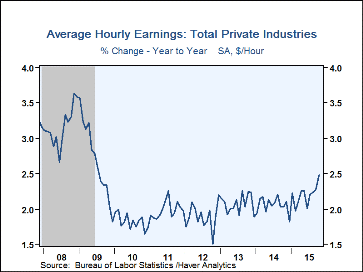 Average hourly earnings improved 0.4% (2.5% y/y),
equaling the strongest gain since January. It was driven by a 0.7% rise (2.6%
y/y) in construction earnings and a 0.5% increase (2.5% y/y) in leisure &
hospitality. Factory sector earnings ticked 0.1% higher (2.0% y/y) for a second
straight month and earnings in retail trade grew 0.2% (3.2% y/y).
Average hourly earnings improved 0.4% (2.5% y/y),
equaling the strongest gain since January. It was driven by a 0.7% rise (2.6%
y/y) in construction earnings and a 0.5% increase (2.5% y/y) in leisure &
hospitality. Factory sector earnings ticked 0.1% higher (2.0% y/y) for a second
straight month and earnings in retail trade grew 0.2% (3.2% y/y).
From the household employment survey, the dip in the unemployment rate to 5.0% reflected a 320,000 increase (1.3% y/y) in employment and a labor force rise of 313,000 (0.5% y/y). The labor force participation held steady at 62.4%, its lowest level since October 1977. The number of potential workers not in the labor force grew 2.3% y/y to 94.513 million.
The average duration of unemployment increased to 28.0 weeks from the cycle high of 40.6 weeks in July 2011. Those who were out of work for 52 weeks or more fell 26.9% y/y.
The unemployment rate for individuals without a high school diploma fell to 7.4% and the rate for high school graduates with no college held steady at 5.2%. For those with less than a college diploma, the unemployment rate was 4.4% while for individuals with a bachelors degree or higher it was 2.5%.
The labor market data is contained Haver's USECON database. Detailed figures are in the EMPL and LABOR databases. The expectations figure is in the AS1REPNA database.
Are Wages Useful in Forecasting Price Inflation? from the Federal Reserve Bank of San Francisco is available here.
| Employment: (SA M/M Change, 000s) | Oct | Sep | Aug | Y/Y | 2014 | 2013 | 2012 |
|---|---|---|---|---|---|---|---|
| Payroll Employment | 271 | 137 | 153 | 1.9% | 1.9% | 1.7% | 1.7% |
| Previous | -- | 142 | 136 | -- | -- | -- | -- |
| Manufacturing | 0 | -9 | -19 | 0.5 | 1.4 | 0.8 | 1.7 |
| Construction | 31 | 12 | 8 | 3.5 | 4.8 | 3.7 | 2.1 |
| Private Service Producing | 241 | 159 | 146 | 2.5 | 2.2 | 2.2 | 2.2 |
| Government | 3 | -12 | 28 | 0.5 | 0.0 | -0.3 | -0.8 |
| Average Weekly Hours - Private Sector | 34.5 | 34.5 | 34.6 | 34.6 (Oct.'14) |
34.5 | 34.5 | 34.4 |
| Private Sector Average Hourly Earnings (%) | 0.4 | 0.0 | 0.4 | 2.5 | 2.1 | 2.1 | 1.9 |
| Unemployment Rate (%) | 5.0 | 5.1 | 5.1 | 5.7 (Oct.'14) |
6.1 | 7.4 | 8.1 |
Tom Moeller
AuthorMore in Author Profile »Prior to joining Haver Analytics in 2000, Mr. Moeller worked as the Economist at Chancellor Capital Management from 1985 to 1999. There, he developed comprehensive economic forecasts and interpreted economic data for equity and fixed income portfolio managers. Also at Chancellor, Mr. Moeller worked as an equity analyst and was responsible for researching and rating companies in the economically sensitive automobile and housing industries for investment in Chancellor’s equity portfolio. Prior to joining Chancellor, Mr. Moeller was an Economist at Citibank from 1979 to 1984. He also analyzed pricing behavior in the metals industry for the Council on Wage and Price Stability in Washington, D.C. In 1999, Mr. Moeller received the award for most accurate forecast from the Forecasters' Club of New York. From 1990 to 1992 he was President of the New York Association for Business Economists. Mr. Moeller earned an M.B.A. in Finance from Fordham University, where he graduated in 1987. He holds a Bachelor of Arts in Economics from George Washington University.


